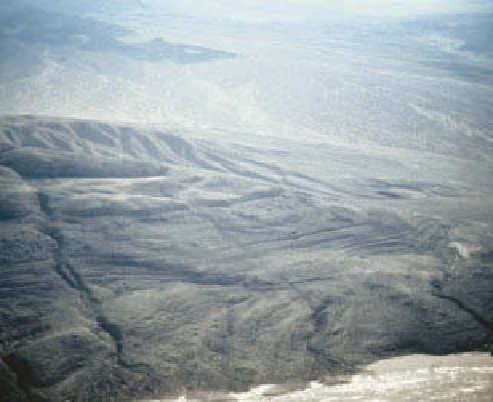Geoscience Reference
In-Depth Information
minerals, but plastic and fluid behaviour is not restricted
to fine-grained soils. Under exceptional water pressures,
large boulders and grains may become fluidized and move
rapidly downslope as
debris flows
when grain collisions
replace water as the buoyancy source. Water content also
fluctuates with the weather and the seasons. Intense
precipitation or spring melt may induce pore water
pressures to rise rapidly. Steep slope angles and the
proximity of rock walls generate rapid run-off which
readily infiltrates slope colluvium. Drainage is then
inhibited by marked reductions in permeability at the
colluvium/bedrock boundary, or by perched water
tables associated with
indurated
(cemented) or clay-rich
horizons. Other significant clay-water interactions include
the behaviour of
sensitive
or
quick clays
(e.g. illite), which
can lose structure and shear at relatively low moisture
contents, or
swelling clays
(e.g. montmorillonite), which
establish expansive (heaving or uplifting) forces as they
absorb water.
which once occupied Death Valley. Parallel and horizontal shore-
lines indicate periods of tectonic quiescence, whereas other
tilted shorelines attest to subsequent tectonic disturbance.
Photo: Dee Trent
Slope failure: materials and modes
There have been many attempts to classify mass wasting
comprehensively, mostly by civil engineers, with varying
degrees of success and acceptance. It is difficult to
pigeonhole events in which material properties and style
of motion may change in transit, leading to a wide range
of landforms. Tidy schemes on paper cannot discriminate
easily between processes operating over a
continuum
of
properties. Criteria widely used are as follows:
type of
material
- rock, rock debris, soil;
mode of failure
- fall,
In granular materials, moderate pore water levels
generate cohesion or negative pore water pressure. Positive
pore water pressures develop as water content rises,
transferring some of the normal stress from grains to pore
water and comprehensively reducing shear strength.
Plastic
and
liquid limits
define thresholds of increasing
water content at which the mass deforms, first plastically
or then as a viscous fluid (
Figure 13.13
).
They also depend
on particle size character, void ratio and proportion of clay
(a)
(b)
Brittle
solid
Semi-
brittle
Plastic
Viscous
liquid
60
Semi-
solid
40
AIR
20
0
20
35
50
110
Solid
limit
Liquid limit
Plastic limit
Liquid limit, %
Plasticity index
Moisture content, %
Figure 13.13
The influence of water content on soil material properties, measured by (a) Atterberg indices or (b) limits.
Source: After Selby (1993)





























































